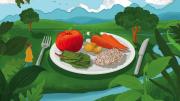It’s widely accepted that diets that emphasize plant-based foods—such as vegetables, fruits, whole grains, and legumes—are beneficial for human health, reducing the risk of chronic ailments such as heart disease. At the same time, mounting evidence shows that plant-based foods are better for the planet than animal products. Producing red meat, for example, requires more resources like land and water than most plant-based options and generates significant quantities of methane, a potent greenhouse gas.
Yet not all plant-based diets are healthy. “If you eat a tofu stir-fry with brown rice and lots of veggies, that’s generally going to be better for your health than eating a vegetarian burger from a fast-food restaurant with a large fries and a large soda,” explains Aviva Musicus, a postdoctoral research fellow at the Harvard T.H. Chan School of Public Health. With assistant professor of nutrition Dong Wang, research professor and professor of medicine Meir Stampfer, and professor of epidemiology and nutrition Walter Willet, Musicus coauthored a November 2022 paper that simultaneously considers plant-based diets’ health and environmental impacts.
The researchers used data from more than 65,000 women enrolled in the Nurses’ Health Study II, a Harvard project that has collected health information from nurses at regular intervals since 1989. Every four years, the nurses also complete a food frequency questionnaire; in the version that Musicus and her colleagues examined, participants were asked how often they ate 156 foods, ranging from yogurt and cantaloupe to avocados and salami.
They categorized the nurses’ diets based on how closely they adhered to different diet profiles previously described by nutrition researchers. One diet pattern was analyzed using the Alternative Healthy Eating Index, developed at Harvard. People who adhere to this pattern “are eating a lot of fruit, vegetables, whole grains, polyunsaturated fats, omega-3 fats, and nuts and legumes,” she explains. “They’re also eating a lot less red and processed meat, trans fats, and sodium, and they’re drinking fewer sugary drinks.”
Another dietary pattern was a healthful plant-based diet, which also emphasizes whole grains, legumes, vegetables, and plant-based oils. Strong adherence to this diet “looks a lot like strong adherence to the Alternative Healthy Eating Index, but without animal products,” Musicus says. The researchers’ analysis showed that for the nurses, higher scores on the Alternative Healthy Eating Index and healthful plant-based diet index were associated with a lower risk of chronic diseases, including cardiovascular disease.
A third diet profile, an unhealthy plant-based diet, also excludes animal-based foods, but is made up of foods widely considered to be unhealthy: white-flour breads and pastas, sodas, fruit juices, and French fries. Unsurprisingly, the researchers found that this pattern boosted the nurses’ risk of cardiovascular disease.
To capture the environmental impact of each diet, researchers created a database of the 156 foods on the nurses’ food frequency questionnaire, focusing on “everything that happens before that food leaves the farm,” Musicus says. She and her colleagues considered greenhouse gas emissions, cropland and water requirements, and the amount of ecosystem-disrupting nitrogen-based fertilizer needed for each item.
“Basically, we found that diets that are good for human health are also good for environmental health,” she says. For example, the Alternative Healthy Eating Index that “is associated with reduced cardiovascular disease risk also reduced environmental impact in every single category we looked at: lower greenhouse gases, lower use of irrigation water, less nitrogenous fertilizer, and less cropland.” That analysis also echoed previous findings that red meat and processed meats had the most significant environmental impacts of all foods on the list (see “Eating for the Environment,” March-April 2017, page 11).
Musicus was particularly surprised by findings related to nut consumption; nuts such as almonds are often criticized for being a water-intensive crop in California, a state struggling to conserve water. Yet the research team found that nuts accounted for only about 5 percent of irrigation water use in the nurses’ diets compared with 26 percent attributable to red and processed meat, and about 25 percent attributable to vegetables, she says: “Nuts were responsible for proportionally less water in participants’ diets because [they] consume them in smaller amounts than red and processed meat and vegetables.” Nuts also require less water per calorie than red meat.
The analysis further revealed that some unhealthy plant-based foods, namely sugar-sweetened beverages and sweets, can harm the environment. “They use up a surprising amount of fertilizer proportionally, based on the nurses’ total dietary intake,” Musicus explains. At the same time, “They had lower greenhouse gas emissions than many other food categories, so it’s kind of a nuanced issue”—at least in environmental terms.
Based on these results, the authors recommend that future U.S. dietary guidelines acknowledge the environmental sustainability of different food choices. Countries including Brazil, Canada, Denmark, and Sweden already mention sustainability alongside health impact in their dietary guidelines. The advisory committee for the 2015-2020 Dietary Guidelines for Americans did recommend that the U.S. guidelines include sustainability as a factor to weigh when making diet choices. “And they specifically recommended a reduction in red and processed meat consumption,” Musicus explains. But, she continues, beef producers lobbied Congress, “which then directed the U.S. Department of Agriculture and Department of Health and Human Services to omit sustainability” from those guidelines.
Despite this omission, “There’s a growing movement around the idea that it’s really important that we recognize food system sustainability in addition to the nutrition of the foods we eat,” Musicus says. Dietary guidelines influence more than personal food choices; they’re also used to shape some federal nutrition programs, including the national school lunch program and the meals served to military personnel. “If we change the dietary guidelines to include sustainability and perhaps recommend less red and processed meat consumption because it’s good for the environment and it’s good for our bodies,” she concludes, “that could influence tens of millions of American diets automatically.”









